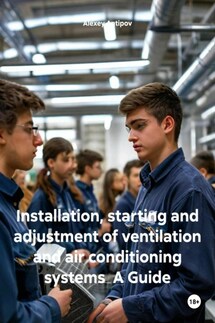Installation, starting and adjustment of ventilation and air conditioning systems A Guide - страница 3
Air distributors are installed in suspended ceilings, some are mounted at a low height above the working area.
A type of supply ventilation systems is air shower, which provides a concentrated flow of air to the workplace. A workplace is a platform with a diameter of 1 m, on which the worker is at least 4 hours per shift or 2 hours continuously. Such an air supply is necessary for intensive thermal (from 300 to 3000 W/m2 or more) irradiation of workers, or for open production processes with the release of harmful gases and vapors, when it is impossible to arrange local shelters. Actually, the scheme of air douching does not differ from the supply ventilation system, but instead of air distributors, showering rotary nozzles are installed.
Air and thermal-air curtains are designed to protect the gates and open entrances of industrial buildings from the intake of cold air in winter. There are two types of curtains: sliding, in which a flat jet of air is supplied either from below or from the sides of entrances and gates at some angle towards cold air, and mixing, when air from the building is supplied to the vestibule between the double entrance doors. Mixing curtains are used in administrative and public buildings, in passageways, etc. Curtains in which the air is preheated in an air heater are called thermal-air, and curtains that supply air without heating are simply air type.
Air-heating units with full or partial air recirculation are often used in air heating systems.
General exchange exhaust ventilation systems usually remove air from the upper, less often from the middle zone of buildings. Before removal, the air in general exchange exhaust systems usually does not undergo cleaning. General exchange exhaust systems can be channelless if the air is removed by roof fans that are installed on the floors, and ducted. In ducted exhaust ventilation systems, air is sucked into air intake apertures or grilles, it is fed through the ducts to the fan and, after passing the exhaust shaft, enters the atmosphere. To protect the exhaust shaft from atmospheric precipitation, an umbrella is installed above it, and the air ducts are blocked with a flap when the fan is not working.
Local exhaust ventilation systems are designed to take harmful emissions from the places of their formation with the help of shelters or local suction, transport polluted air, clean it in filters or dust collectors and release it into the atmosphere. Local suction and shelters have the most diverse design and shape: these are umbrellas, fume hoods, full shelters, side and ring suction at baths and shaft furnaces, suction panels, casings, etc.
Many harmful substances released during technological processes actively affect local suction pipes, air ducts, fans, filters, causing their severe corrosion, in addition, they can be explosive and fire-hazardous. In these cases, air ducts and other devices in contact with an aggressive environment are made of materials that are not subject to intense corrosion by the moving medium (corrosion-resistant alloy steels, aluminum, titanium. metal, vinyl, polyethylene, etc.), or apply special coatings of steel ducts with acid- and alkali-resistant dyes, enamels and varnishes. In such systems, fans and other equipment are installed in an intrinsically safe protected design.






